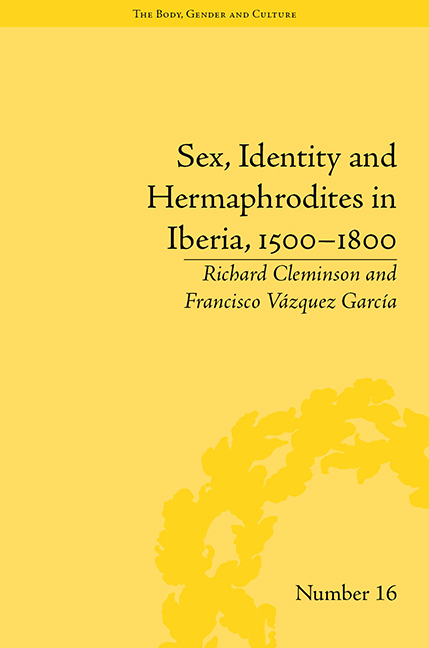Book contents
- Frontmatter
- CONTENTS
- Acknowledgements
- Introduction: Sex, Gender and Historicity
- 1 Marvels, Monsters and Prodigies: Hermaphrodites as Natural Phenomena in Spain, 1500–1700
- 2 Sexual Transgression and Hermaphroditism: The ‘New World’ and Imperial Subjectivity
- 3 The Expulsion of the Marvellous: The Decline of the ‘One-Sex’ Model, 1750–1830
- 4 Hermaphroditism in Portugal
- Conclusion
- Notes
- Works Cited
- Index
3 - The Expulsion of the Marvellous: The Decline of the ‘One-Sex’ Model, 1750–1830
- Frontmatter
- CONTENTS
- Acknowledgements
- Introduction: Sex, Gender and Historicity
- 1 Marvels, Monsters and Prodigies: Hermaphrodites as Natural Phenomena in Spain, 1500–1700
- 2 Sexual Transgression and Hermaphroditism: The ‘New World’ and Imperial Subjectivity
- 3 The Expulsion of the Marvellous: The Decline of the ‘One-Sex’ Model, 1750–1830
- 4 Hermaphroditism in Portugal
- Conclusion
- Notes
- Works Cited
- Index
Summary
An Unusual Case: Fernanda Fernández, the Capuchine Nun
As we have argued in previous chapters, stories about people who suddenly changed sex were relatively common in literature that depicted the marvels and wonders of the world, the ‘relaciones de sucesos’ and the anatomical treatises that were published in Spain in the sixteenth and seventeenth centuries. According to the renowned and, by now, questioned thesis offered by Laqueur, sex change and news about the births of hermaphrodites in the human species would concur with the predominance of the one-sex model, which in turn was driven by a medical understanding based on the thought of Galen and Hippocrates. Laqueur also argued that this model began to break down in the West during the Enlightenment and the liberal revolutions and was replaced by a dichotomous model that continues to this day.
However, in Spain at the end of the eighteenth century, in contrast to what was occurring in other European countries, news about sex changes and hermaphrodites continued to be common currency in intellectual and popular spheres. An example of the longevity of the older model is the case of Fernanda Fernández. Fernández was born in Baza and became a nun in the Capuchine convent in Granada. She remained part of the order until the age of twenty-seven, when she started to notice signs of masculinity in her body. In two years the sexual transformation was complete.
- Type
- Chapter
- Information
- Sex, Identity and Hermaphrodites in Iberia, 1500–1800 , pp. 65 - 84Publisher: Pickering & ChattoFirst published in: 2014



